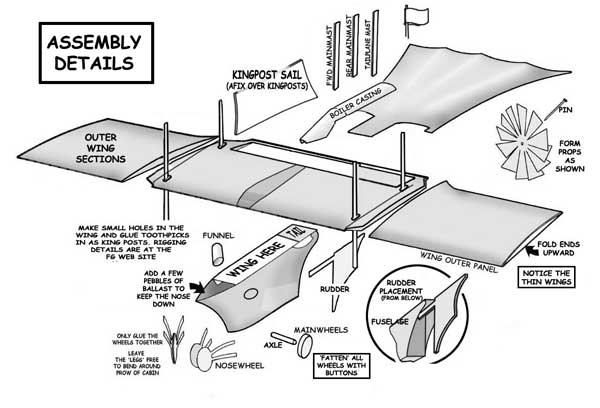

William Henson's "Ariel" Early Flying Machine - Aerial Steam Carriage
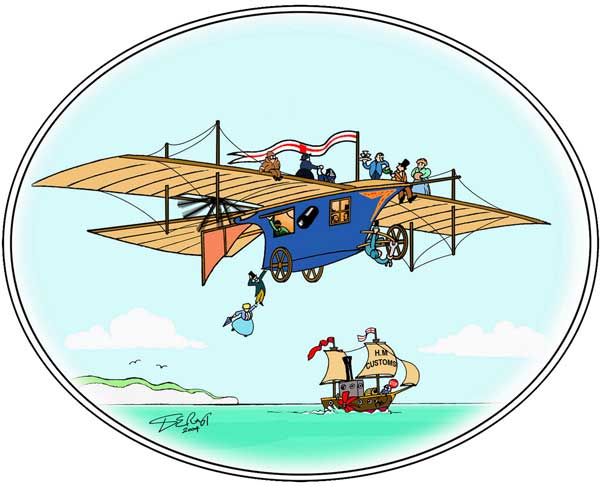
This original artwork by Derek Roberts is available in much higher quality (suitable for framing), on the Full Collection DVD.
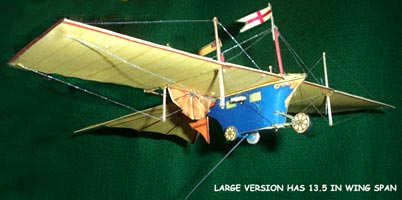
To finance the building of his giant steam-powered airplane, Henson tried to organize an "Aerial Transit Company" in 1843.
Many widely-published illustrations showed the Henson's Ariel called his machine-in effortless flight over China, India, and the pyramids of Egypt.
Such grandiose and premature announcements subjected the inventor to great ridicule when his scheme collapsed, but the publicity had gone far to condition even a skeptical and indifferent public to the idea of fixed-wing, propeller-driven aircraft.
The Ariel was to be the preview of what was to soon be in aviation.
Interesting point! I have not come across much in the way of colored renditions of said Aerial Steam Carriage, and what I have seen has been dull, dull, dull! The Victorians were well into somber colors, remember (check out any decor from the era, it may have been very fancy, but on the whole was pretty unspectacular color-wise) I think that's because the project never got off the ground (heh heh) he never got the opportunity to really pitch his sale technique to Joe Public. I guess we'll have to take up where he left off! ...Derek Roberts
Download successful and complete. The carriage is such a pretty blue! I see that I will need to pick up another spool of thread . . . The group of figures that Derek included are a nice touch. They will give an idea of how large it was to have been. Nobody, nobody else in the papermodelling industry gives as much information as FG does. Useful information that is really needed. And do it so that it creates a warm smile, at least, on my face. ymp, John
.. Thanks for another great model! I look forward to renewing (at least) my magic key! joe
As they were powered by steam, which was a proven technology, they were off to a flying start (hehe) But the problem with steam engines was always to get a good power to weight ratio. An Englishman named Stringfellow built a tiny steam engine for a model plane in the late 1800's (about 16 cubic inch) which was replicated by apprentices at Rolls Royce some time ago. They weren't allowed to build it as Stringfellow intended, though, health and safety considerations meant that in effect Stringfellow made the boiler from such lightweight material it was considered extremely dangerous! But these early pioneers were pushing the technology of the day to it's limits and of course, it wasn't until Mr Benz and Mr Daimler invented their internal combustion engines that a truly practical form of motive power for air machines came along. Here endeth the lesson!! Derek
I love the history that comes along with these models. I don't build them all, but I love to download them and look at your designs and read the information you have on your web pages. Thanks for all the fun learning! - Jim M. from Canada
Henson Early Flying- Aerial Steam Carriage
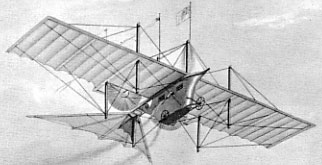
William Samuel Henson was an engineer and inventor who was familiar with the aeronautical work of George Cayley. Discussions with his associate John Stringfellow led to his design for a large passenger-carrying steam-powered monoplane, with a wing span of 150 feet, named "ARIEL - The Henson Aerial Steam Carriage," which he patented in 1842. Henson, Stringfellow and two others, Frederick Marriott and D. E. Colombine, incorporated the Aerial Transit Company in 1843, and fully intended to construct the flying machine.
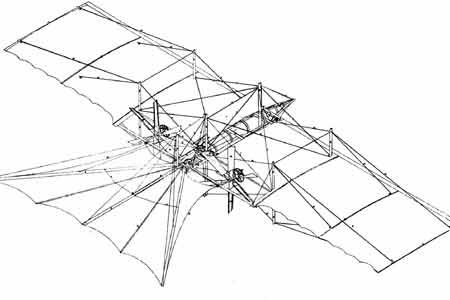 Henson had demonstrated a model of his design, which
may or may not have made at least one tentative steam powered
flight, as it lifted, somewhat, off a wire guide. Numerous attempts
to actually fly the large model (and an even larger model with
a 20 foot wing span) were made between 1844 and 1847, but none
of the attempts were unsuccessful.
Henson had demonstrated a model of his design, which
may or may not have made at least one tentative steam powered
flight, as it lifted, somewhat, off a wire guide. Numerous attempts
to actually fly the large model (and an even larger model with
a 20 foot wing span) were made between 1844 and 1847, but none
of the attempts were unsuccessful.
The Aerial Transit Company's publicist, Frederick Marriott, had a number of prints made in 1843 depicting the Aerial Steam Carriage over the pyramids in Egypt, in India, over London, England, and other places, which drew considerable interest from the press. Not all of the attention was approving, many in the press were extremely skeptical of the motives of the Aerial Transit Company, essentially raising questions of whether the group was a hoax or a fraud.
This could have not been very welcome considering how seriously Henson and his group had taken the project, and given that the model Aerial Steam Carriage had not performed as expected.
As can be seen in the illustrations below, quite detailed plans were drawn for the Aerial Steam Carriage and great consideration was given to a number of necessary elements, such as flight control and wing loading. The planned construction of the wings is particularly noteworthy for it set a pattern which was followed well into The Great War, WWI. The rectangular wings were curved on the tops and bottoms, not flat surfaces, and were formed by wooden ribs attached to wooden spars (hollow cylinders which gradually tapered to the ends) and covered with fabric, and were braced, internally and externally, with wires. Henson's design was very influential and his detailed patent drawings contained a wealth of well-conceived and well-executed ideas for a flying machine.
It was also the first recognizably "modern" monoplane
design, with a three-wheeled landing gear, and powered by two
contra-rotating six-bladed propellers. While certain design elements,
most notably the tail, were somewhat bird-like, the overall impression
one has of the "ARIEL" is that it is a true flying machine,
not an imitation of a bird. The Aerial Steam Carriage never took
to the air, but it nonetheless registered firmly in the minds
and imaginations of multitudes of people to became one of the
strongest
archetypal images of early aeronautics.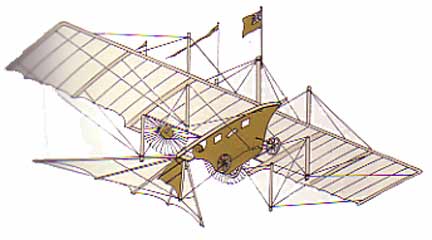
The Aerial Transit Company never built the large version of the Aerial Steam Carriage, perhaps because of the disappointing experiments with the model craft and, perhaps, because of the expense involved. Henson, Stringfellow, Marriott and Colombine parted company.
In 1848 William Henson and his wife, Sarah, left their native England and moved to the U.S., settling in Newark, New Jersey, where he spent the last 40 years of his life. Henson had apparently ceased his aerial research for good, and never again took up the matter. Henson, along with his wife and children, and other members of their family are buried in Orange, New Jersey.
Born in 1812,William Samuel Henson was, like his father, a successful industrialist in the lace making business in Somerset, England. In 1840, under the influence of Cayley's early writings, Henson and an engineer who also worked in the lace making industry, John Stringfellow, designed a steam-driven airplane they called an "aerial steam carriage." There were many elements of the design of the Ariel (as Henson called it) that proved to be prophetic of later aircraft, and a simple glance at the design makes one feel as if one is looking at a cartoon prototype of the modern airliner. In fact, Henson and Stringfellow planned to create an international airline, the Aerial Transit Company, and proceeded to raise investment capital.They embarked on a massive publicity campaign that involved illustrations of the Ariel in flight over London and exotic settings in Egypt, India, and China.
 They hoped that the illustrations would make people believe the
aircraft was an established fact. These illustrations appeared
in newspapers, magazines, on handkerchiefs, trays, wall tapestries,
and lace-frilled placemats. The public was caught unprepared for
this barrage, and instead of taking to the idea, investors who
might have supported it withdrew. Henson then appealed to George
Cayley, who declined to invest (or even to endorse the idea until
they built a working model of the Ariel).
They hoped that the illustrations would make people believe the
aircraft was an established fact. These illustrations appeared
in newspapers, magazines, on handkerchiefs, trays, wall tapestries,
and lace-frilled placemats. The public was caught unprepared for
this barrage, and instead of taking to the idea, investors who
might have supported it withdrew. Henson then appealed to George
Cayley, who declined to invest (or even to endorse the idea until
they built a working model of the Ariel).
The pair built a model in 1847, but the steam engine Stringfellow had designed was simply not powerful enough. Finally, Henson abandoned the entire project and emigrated to the United States, but Stringfellow stayed on and in 1848 tried once more to fly a model with an improved steam engine. The results were disappointing-nothing more than a short, uncontrolled hop. At this point, Stringfellow also gave up, and the entire episode was forgotten. But the Ariel did have some positive effects: its design prompted Cayley to rethink wing configuration and come up with the multiple-wing design, a feature of nearly all the early successful aircraft. The plane itself was logically designed and inspired many later builders. In spite of the scorn heaped on Henson and Stringfellow's outrageous publicity, the many illustrations that found their way all over the world placed the issue of aviation and the possibility of comfortable flight to faraway places squarely before the popular consciousness.
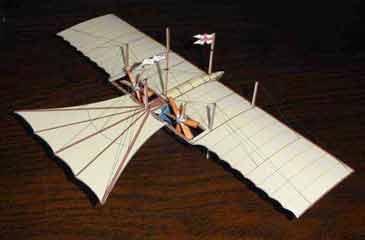
Specifications for Henson's Ariel - Aerial Steam Carriage
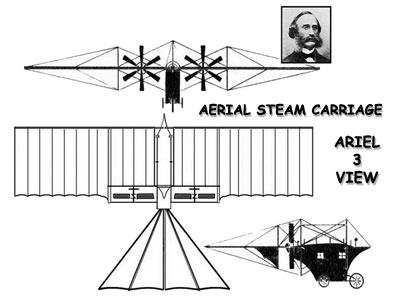 |
Passangers: 10-12 |



